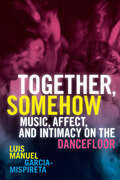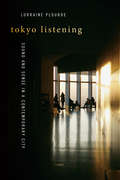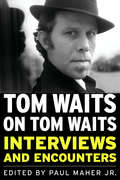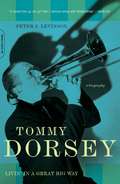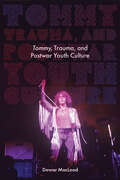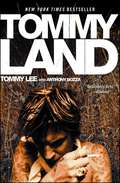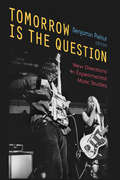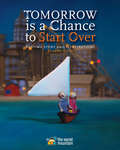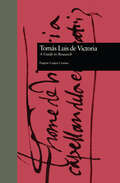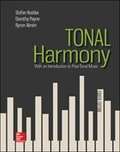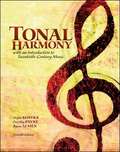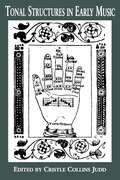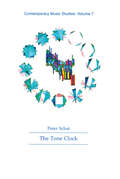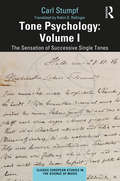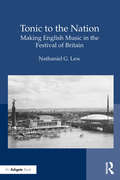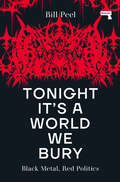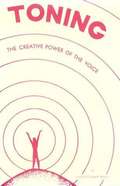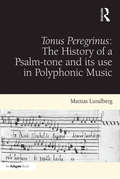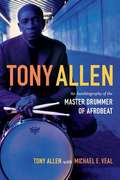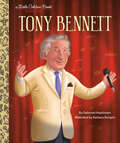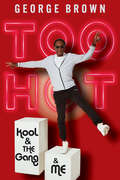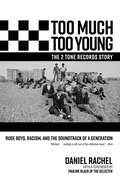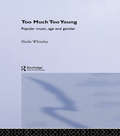- Table View
- List View
Together, Somehow: Music, Affect, and Intimacy on the Dancefloor
by Luis Manuel Garcia-MispiretaIn Together, Somehow, Luis Manuel Garcia-Mispireta examines how people find ways to get along and share a dancefloor, a vibe, and a sound. Drawing on time spent in the minimal techno and house music subscenes in Chicago, Paris, and Berlin as the first decade of the new millennium came to a close, Garcia-Mispireta explains this bonding in terms of what he calls stranger-intimacy: the kind of warmth, sharing, and vulnerability between people that happens surprisingly often at popular electronic dance music parties. He shows how affect lubricates the connections between music and the dancers. Intense shared senses of sound and touch help support a feeling of belonging to a larger social world. However, as Garcia-Mispireta points out, this sense of belonging can be vague, fluid, and may hide exclusions and injustices. By showing how sharing a dancefloor involves feeling, touch, sound, sexuality, and subculture, Garcia-Mispireta rethinks intimacy and belonging through dancing crowds and the utopian vision of throbbing dancefloors.
Tokyo Boogie-Woogie: Japan's Pop Era and Its Discontents
by Hiromu NagaharaEmerging in the 1920s, the Japanese pop scene gained a devoted following, and the soundscape of the next four decades became the audible symbol of changing times. In the first English-language history of this Japanese industry, Hiromu Nagahara connects the rise of mass entertainment with Japan’s transformation into a postwar middle-class society.
Tokyo Listening: Sound and Sense in a Contemporary City (Music / Culture)
by Lorraine PlourdeTokyo Listening examines how the sensory experience of the city informs how people listen to both music and everyday, ubiquitous sounds. Drawing on recent scholarship in the fields of sound studies, anthropology, and ethnomusicology and over fifteen years of ethnographic fieldwork in Japan, Lorraine Plourde traces the linkages between sound and urban space. She examines listening cultures via four main ethnographic sites in Tokyo—an experimental music venue, classical music cafes, office workspaces, and department stores—looking specifically at how such auditory sensibilities are cultivated. The book brings together two different types of spaces into the same frame of reference: places people go to specifically for the music, and spaces where the music comes to them. Tokyo Listening examines the sensory experience of urban listening as a planned and multifaceted dimension of everyday city life, ultimately exploring the relationship between sound, comfort, happiness, and productivity.
Tom Waits on Tom Waits: Interviews and Encounters (Musicians In Their Own Words Ser.)
by Paul MaherThis autobiographical portrait of Tom Waits takes shape through a selection of more than 50 interviews. Starting with the first interview--on KPFK-FM's Folkscene in 1973--Waits speaks out on a variety of topics and shares something truly unique with his readers. In a rap that is a synthesis of inflections--Louis Armstrong, Charles Bukowski, Jack Kerouac, Mark Twain, hobo, pool hall attendant, vaudevillian huckster, musicologist par excellence, and a fresh slathering of the organic word-ooze of William S. Burroughs--Waits comes across as well read, informed, and lucidly aware of current pop culture. He delivers prose as crafted, poetic, potent, brilliant, and haunting as the lyrics of his best songs.
Tommy Dorsey: Livin' in a Great Big Way
by Peter J. LevinsonThe definitive and invaluable ("Los Angeles Times") biography of the legendary jazz giant Tommy Dorsey
Tommy, Trauma, and Postwar Youth Culture (Excelsior Editions)
by Dewar MacLeodTommy, Trauma, and Postwar Youth Culture traces the development of one of rock music's central masterpieces and its relation to the social-cultural history of the era. Composer and guitarist Pete Townshend was the creative force behind the Who, one of Britain's greatest rock bands. Townshend grew up in an England decimated by the loss of life and hope that was the initial legacy of World War II. The product of a troubled childhood, Townshend faced ongoing struggles with sexual and personal trauma that colored his later work as a performer. An ambitious composer who wanted to create both pop hits and lasting personal works, Townshend achieved his greatest success with the Who through their 1969 rock opera, Tommy. Townshend gave many accounts of the work's evolution and its significance to him and he participated in and encouraged its continued legacy. Dewar MacLeod recounts his own interactions with Townshend and Tommy to draw out the work's impact, its critical reception, its place both in postwar history and the rock era, and its continuing relevance. This book will appeal to all interested in the history of rock, the creative process, and the long shadow of the 1960s.
Tommyland
by Tommy LeeI am Tommy Lee, born Thomas Lee Bass in Athens, Greece, on October 3, 1962, and raised in a suburb of California by an American father and a Greek mother. At seventeen, I joined Mötley Crüe and we became one of the baddest-ass rock bands in history. We sold over 40 million albums, we wreaked havoc, we scared parents, and we titillated too many fathers' daughters. I've been married three times: once for just a few days to a Penthouse Pet, for seven years to Heather Locklear, and then for five years to Pamela Anderson, with whom I have two beautiful sons. I've gotten into a lot of fights and I've been to jail a few times.But this book isn't your typical journey in a straight line from day one to day now. I'm more interested in revealing what's most important about my life, like how I cook my steaks; what I think of the tabloids, the truth, my ex-wives, my ex-band, my music; and what an innocent observer might find hanging around my house any given Sunday. You'll get plenty of facts and I'll tell you a story, but my real mission here is to paint you a picture of my life. I want to show you how my memories smell.I'd like to get into it now, so please take your seats. I advise you to keep your arms and legs inside the car at all times. If you have a pacemaker, a heart condition, or if you are pregnant or too damn short to reach the safety bar, I ask that you turn back immediately. Those with weak stomachs, strict morals, or chronic indigestion should put the book down now. For the rest of you, there's one truth that's real across the board: What you send out is what you get back. Send out the good, people, and it will come back to you. There's another thing I've learned over the years, in court, in fights, and in arguments with people I love: There isn't one truth, there are many. This book is my truth.NOTE: THE EBOOK DOES NOT INCLUDE PHOTOGRAPHS THAT APPEAR IN THE PRINT EDITIONS.
Tomorrow Is The Question: New Directions In Experimental Music Studies
by Benjamin Piekut"In recent decades, experimental music has flourished outside of European and American concert halls. The principles of indeterminacy, improvisation, nonmusical sound, and noise, pioneered in concert and on paper by the likes of Henry Cowell, John Cage, and Ornette Coleman, can now be found in a variety of new locations: activist films, rock recordings, and public radio broadcasts, not to mention in avant-garde movements around the world. The contributors to Tomorrow Is the Question explore these previously unexamined corners of experimental music history, considering topics such as Sonic Youth, Julius Eastman, the Downtown New York pop avant-garde of the 1970s, Fluxus composer Benjamin Patterson, Tokyo's Music group (aka Group Ongaku), the Balinese avant-garde, the Leicester school of British experimentalists, Cuba's Grupo de Experimentación Sonora del ICAIC, Pauline Oliveros's score for the feminist documentary Maquilapolis, NPR's 1980s RadioVisions, and the philosophy of experimental musical aesthetics. Taken together, this menagerie of people, places, and things makes up an experimentalism that is always partial, compromised, and invented in its local and particular formations--in other words, these individual cases suggest that experimentalism has been a far more variegated set of practices and discourses than previously recognized. Asking new questions leads to researching new materials, individuals, and contexts and, eventually, to the new critical paradigms that are necessary to interpret these new materials. Tomorrow Is the Question, gathering contributions from historical musicology, enthnomusicology, history, philosophy, and cultural studies, generates future research directions in experimental music studies by way of a productive inquiry that sustains and elaborates critical conversations"--
Tomorrow Is a Chance to Start Over
by Hilary GristWinner of:2015 National Association of Parenting Publications, Gold Award2015 Parents' Choice RecommendedNominee:2015 Canadian Folk Music Award, Best Children's AlbumA fresh, original project that will appeal to young parents who are fans of musical artists Feist or Norah Jones Ira and Isabelle, who live in a little red house by the sea, decide one night to escape the sound of the city's beeping cars and sail off to a faraway land where they learn from a new friend—a robin with a soft voice—that dreams really can come true. The book contains an audio CD that features the narrated story as well as 10 original heartwarming dream songs, and an ethereal rendition of Johannes Brahms' classic "Cradle Song."
Toms Luis de Victoria: A Guide to Research (Routledge Music Bibliographies)
by Eugene Casjen CramerFirst published in 1998. Routledge is an imprint of Taylor & Francis, an informa company.
Tonal Harmony
by Stefan Kostka Dorothy Payne Byron AlménFor a generation of professionals in the musical community, Tonal Harmony has provided a comprehensive, yet accessible and highly practical, set of tools for understanding music. With this new edition, twenty-first century technology meets a time-honored tradition. Now available in McGraw-Hill’s Connect® with SmartBook®, students are better equipped to understand and master the vocabulary of music efficiently,allowing them to move on more quickly to advanced musical skill-building.
Tonal Harmony (Seventh Edition)
by Stefan Kostka Dorothy PayneFor over two decades Tonal Harmony has been the leading text for the two-year theory curriculum for music majors. Used at nearly 800 schools, Tonal Harmony has been consistently praised for its practicality and ease of use for student and instructor alike. The straightforward approach is supported by well-chosen examples and thoughtful exercises, and the total presentation is compatible with differing teaching styles and theoretical points of view. In addition, students can purchase a CD of recorded examples for use with the textbook, while audio examples for the workbook are available for download as MP3 files.
Tonal Space in the Music of Antonio Vivaldi
by Bella Brover-LubovskyTonal Space in the Music of Antonio Vivaldi incorporates an analytical study of Vivaldi's style into a more general exploration of harmonic and tonal organization in the music of the late Italian Baroque. The harmonic and tonal language of Vivaldi and his contemporaries, full of curious links between traditional modal thinking and what would later be considered common-practice major-minor tonality, directly reflects the historical circumstances of the shifting attitude toward the conceptualization of tonal space so crucial to Western art music. Vivaldi is examined in a completely new context, allowing both his prosaic and idiosyncratic sides to emerge clearly. This book contributes to a better understanding of Vivaldi's individual style, while illuminating wider processes of stylistic development and the diffusion of artistic ideas in the 18th century.
Tonal Structures in Early Music (Criticism and Analysis of Early Music #Vol. 1)
by Cristle Collins JuddDiscussion of tonal structure has been one of the most problematic and controversial aspects of modern study of Medieval and Renaissance polyphony. These new essays written specifically for this volume consider the issue from historical, analytical, theoretical, perceptual and cultural perspectives.
Tone Clock (Contemporary Music Studies)
by Peter SchatIn addition, The Tone Clock contains a broad selection of Peter Schat's polemical writings, embracing historical, political, aesthetic and environmental perspectives. His book is not just of interest to composers, but it also provides a valuable insight for anyone interested in the development of twentieth-century music.Peter Schat, a former pupil of Pierre Boulez, exposes more than a new theory of music in The Tone Clock. Although he is a long-experienced serialist composer, in devising and using his tone clock system he has reached the clarity and simplicity which comprise two of his major compositional aims. His book, profusely illustrated with clearly analysed musical examples, will enable other composers to achieve similar aims in their own way, while remaining faithful to their own musical personalities.A former pupil of Pierre Boulez, Peter Schat is a well-known Dutch contemporary serialist composer.
Tone Psychology: The Sensation of Successive Single Tones (Classic European Studies in the Science of Music)
by Carl StumpfCarl Stumpf (1848-1936) was a German philosopher and psychologist and a visionary and important academic. During his lifetime, he ranked among the most prominent scientists of his time. Stumpf's intention, as evident in his book, Tone Psychology, was to investigate the phenomenon of tone sensation in order to understand the general psychic functions and processes underlying the perception of sound and music. It could be argued that modern music psychology has lost or perhaps ignored the epistemological basis that Carl Stumpf developed in his Tone Psychology. To gain a confident psychological basis, the relevance of Stumpf's deliberations on music psychology cannot be overestimated. Analyses of the essence of tones, complex tones and sounds are fundamental topics for general psychology and epistemology. By the end of this two-volume work, Stumpf had established an epistemology of hearing. The subject of Volume I is the sensation of successive single tones. Stumpf demonstrates that analysis leads to the realisation of a plurality (is there only one tone or are there several tones?), which is then followed by a comparison: an increase may be observed (one tone is higher than the other) or a similarity may be realised (both tones have the same pitch or the same loudness). With almost mathematical stringency, Stumpf developed a topology of tones. Volume II deals with the sensation of two simultaneous tones (musical intervals). The books are stimulating, rewarding and provocative and will appeal to music psychologists, music theorists, general psychologists, philosophers, epistemologists and neuroscientists.
Tonic to the Nation: Making English Music in the Festival of Britain
by Nathaniel G. LewLong remembered chiefly for its modernist exhibitions on the South Bank in London, the 1951 Festival of Britain also showcased British artistic creativity in all its forms. In Tonic to the Nation, Nathaniel G. Lew tells the story of the English classical music and opera composed and revived for the Festival, and explores how these long-overlooked components of the Festival helped define English music in the post-war period. Drawing on a wealth of archival material, Lew looks closely at the work of the newly chartered Arts Council of Great Britain, for whom the Festival of Britain provided the first chance to assert its authority over British culture. The Arts Council devised many musical programs for the Festival, including commissions of new concert works, a vast London Season of almost 200 concerts highlighting seven centuries of English musical creativity, and several schemes to commission and perform new operas. These projects were not merely directed at bringing audiences to hear new and old national music, but to share broader goals of framing the national repertory, negotiating between the conflicting demands of conservative and progressive tastes, and using music to forge new national definitions in a changed post-war world.
Tonight It’s a World We Bury: Black Metal, Red Politics
by Bill PeelTonight It&’s a World We Bury explores a range of tendencies central to black metal and uncovers their potential as critiques of capitalism.Tonight It's a World We Bury is a radical re-writing of the history and politics of black metal music.Challenging the commonly-held perception that black metal is a genre of the right — full of wannabe Vikings, Nazis, skinheads and other unsavoury characters — Tonight It's a World We Bury looks at an array of black metal artists to re-affirm the genre as radically anticapitalist, revolutionary and left-wing.Utilizing an eclectic range of black metal bands, including Darkthrone, Burzum, Liturgy and Deathspell Omega, and taking in the works of Marx, Nietzsche, Deleuze and more, Tonight It's a World We Bury is a book on black metal like no other.
Toning: The Creative Power of the Voice
by Laurel Elizabeth KeyesToning is an ancient method of healing, which I hope will be recognized and used with new understanding now that we have more scientific explanations for it. It does not depend upon faith, nor belief in the method, any more than these are necessary to our use of electricity to provide light and energy in our daily living. There appear to be certain natural flows of energy in our bodies and if we recognize them and cooperate with them, they benefit us. Toning is not limited to one's religion, or lack of it. It does not require one's belief. Apparently it is not a "gift" but something available to anyone who goes through the mechanics of letting the voice express itself in a natural way. Anyone who can groan can Tone and experience its benefits. There is no mystery about Toning. It can be understood through material science, physiology and psychology as well as the most ancient concepts of man's relationship to his God. Please try it.
Tonus Peregrinus: The History Of A Psalm-tone And Its Use In Polyphonic Music
by Mattias LundbergMattias Lundberg investigates the historical role of a deviant psalm-tone, the tonus peregrinus, focusing on its applications in polyphonic music within all major branches of Western liturgy. Throughout the remarkably persistent tradition of applying this melody to polyphony, from the ninth century right up to the twenty-first, coeval music theory is able to shed light on the problems it has posed to modal and tonal practice at various historical stages. The musical settings studied hold up a mirror to the general development of psalmody, concerning practices of organum, diverse regional forms of fauxbourdon, cantus firmus composition, free imitation, parody, fugue, quodlibet, monody, and many other compositional techniques where the unique features of the psalm-tone have necessitated modification of existing practices. The conclusions drawn reveal a musico-liturgical tradition that was not in real danger of extinction until the general decline of Western liturgy that followed in the eighteenth century, at which point the historiography of the tonus peregrinus became a factor stimulating scholarly and musical interest in its alleged pre-Christian origins. Lundberg demonstrates that the succession of works based on the tonus peregrinus often preserved a distinctly conservative musical and theological conception even during periods of drastic liturgical reform.
Tony Allen: An Autobiography of the Master Drummer of Afrobeat
by Michael E. Veal Tony AllenTony Allen is the autobiography of legendary Nigerian drummer Tony Allen, the rhythmic engine of Fela Kuti's Afrobeat. Conversational, inviting, and packed with telling anecdotes, Allen's memoir is based on hundreds of hours of interviews with the musician and scholar Michael E. Veal. It spans Allen's early years and career playing highlife music in Lagos; his fifteen years with Fela, from 1964 until 1979; his struggles to form his own bands in Nigeria; and his emigration to France.Allen embraced the drum set, rather than African handheld drums, early in his career, when drum kits were relatively rare in Africa. His story conveys a love of his craft along with the specifics of his practice. It also provides invaluable firsthand accounts of the explosive creativity in postcolonial African music, and the personal and artistic dynamics in Fela's Koola Lobitos and Africa 70, two of the greatest bands to ever play African music.
Tony Bennett: A Little Golden Book Biography (Little Golden Book)
by Deborah HopkinsonHelp your little one dream big with a Little Golden Book biography about Tony Bennett, the legendary crooner of pop and jazz classics, including "I Left My Heart in San Francisco." Little Golden Book biographies are the perfect introduction to nonfiction for preschoolers!This Little Golden Book about Tony Bennett--beloved and award-winning singer and painter whose voice has touched people&’s hearts--is an inspiring read-aloud for young children, as well as their parents and grandparents who grew up listening to his records.Look for more Little Golden Book biographies: • Willie Nelson • Beyoncé • Dolly Parton • Taylor Swift
Too Hot: Kool & the Gang & Me
by George Brown Dave SmithermanGrowing up around music, young George was inspired to piece together a makeshift drum set and teach himself to play as he practiced in the dark, dank basement of his run-down New Jersey row house. He soon joined forces with his friends to form a group called the Jazziacs which then evolved into Kool & The Gang, a band that began playing clubs and charting hits while its members were still teenagers. By evolving their sound as musical tastes changed, the band was able to stay on the charts for decades, scoring twelve top-ten hits in funk, R&B, pop, and rock, and selling over seventy million albums while navigating the highs and lows of their career. In Too Hot, drummer, keyboardist, and primary songwriter George Brown describes life in and out of the band, including a raucous life on the road as the band's popularity grew. He weathered the ups and downs of his musical career and navigated many challenges including prescription drug addiction, depression, and health issues. George shares how his recent cancer scare, and subsequent treatment, compelled him to share his story, warts and all, to give readers a glimpse into a band whose reputation was considered relatively tame, but in reality, it was exactly the opposite.George hopes to help others realize their own professional and personal dreams—life is a symphony, and we must all be our own conductor.
Too Much Too Young, the 2 Tone Records Story: Rude Boys, Racism, And The Soundtrack Of A Generation
by Daniel RachelThe definitive and remarkable story of 2 Tone Records, featuring an introduction by Pauline Black —A Times/Sunday Times Book of the Year—An Uncut Book of the Year —Long-Listed for the Penderyn Music Book Prize —A Louder Than War Book of the Year —A Blitzed Magazine Book of the Year In 1979, 2 Tone Records exploded into the consciousness of music lovers in Britain, the US, and beyond, as albums by the Specials, the Selecter, Madness, the English Beat, and the Bodysnatchers burst onto the charts and a youth movement was born. 2 Tone was Black and white: a multiracial force of British and Caribbean musicians singing about social issues, racism, class, and gender struggles. It spoke of injustices in society and fought against rightwing extremism. It was exuberant and eclectic: white youths learning to dance to the infectious rhythm of ska and reggae, crossed with a punk attitude, to create an original hybrid. The idea of 2 Tone was born in Coventry, England, and masterminded by a middle-class art student, Jerry Dammers, who envisioned an English Motown. Dammers signed a slew of successful artists, and a number of successive hits propelled 2 Tone onto Top of the Pops and into the hearts and minds of a generation. However, infighting among the bands and the pressures of running a label caused 2 Tone to bow to the inevitable weight of expectation and recrimination. Over the following years, Dammers built the label back up again, entering a new phase full of fresh signings and a beautiful end-piece finale in the activist hit song “(Free) Nelson Mandela.” Told in three parts, Too Much Too Young is the definitive story of a label that for a brief, bright burning moment shaped British, American, and world culture.
Too Much Too Young: Popular Music Age and Gender
by Sheila WhiteleyToo Much Too Young investigates how age and gender have shaped the careers and images of pop music stars, examining the role of youth and youthfulness in pop music through a series of themed case studies. Whiteley begins by investigating the exploitation of child stars such as Brenda Lee and Michael Jackson, offering a psychoanalytic reading of the relationship between child star and oppressive manager, and looks at the current glut of boy- and girl- bands and stars in the mold of Britney Spears to examine the continuing fatal attraction of stardom for adolescents. Whiteley then considers the star images of female singer-songwriters Kate Bush, Tori Amos, and Bjork, whose 'little girl' voices and characterization by the media suggests a girlish feminitity which is often at odds with the intentions of their musical output. She then moves on to explore the rock/pop divide as it affects the image of male performers, considering why male stars usually fall into the category of 'wild boys' such as Kurt Cobain or Jim Morrison, or 'nice boys', like Cliff Richard, The Monkees, and Wham! Whiteley ends by asking what happens to stars who set so much store by manipulations of youthfulness when they begin to age, and points to stars like Robbie Williams, Kylie Minogue and Cher to demonstrate that it is possible to achieve iconic pop status even without dying young.
